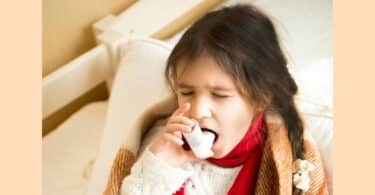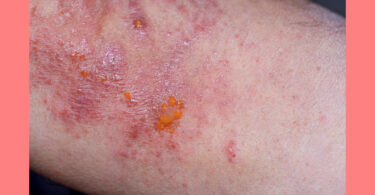A patient seeking treatment for bronchial asthma and acne was treated successfully with a single remedy. As students and practitioners of the sensation method, it is easy to lose our way in the words of the patient. However, a sound case taking process grounds us and guides us to the right remedy. The case-witnessing process, (which has been used here) consists of three steps – the passive case witnessing process, the active and the active-active case witnessing process. The case progressed beautifully with a complete cure over a period of a few years. I hope you all enjoy reading it as much I did, sharing it.
A female patient 27 years of age, consulted me for treatment of asthma, which she suffered from infancy and was currently on inhalers twice a day. She had also developed acne vulgaris on her face the last 5 years.
I start with the Passive Case-Witnessing Process (PCWP) where the patients speak spontaneously about themselves. The purpose of PCWP is to note –
- The Focus, which is the most repetitive expression (verbal or non-verbal) or where we see maximum sensitivity/energy of the patient
- Whether the patient is in touch with their emotions/delusions/sensation?
- Level of experience, the level at which the patient is expressing, whether in name or fact/ feelings/delusions/sensation/energy and source
- The Area, where the patient is expressing this sensitivity/ energy
(**The case has been edited for the sake of brevity.)
Passive Case Witnessing Process –
D: Tell me about yourself.
P: I am a very ‘silent’ type of person, but if others torture me then I get hyper. I care about my family a lot. Going through a lot of stress right now, going through torture because of sister’s affair. Lot of torture is coming my way. If work pressure increases then I become … (Hand Gesture {HG} – hand moving up and down)
I can’t mix up easily. I can’t react easily to things. I can’t speak up during group discussions.
D: Tell more about yourself
P: I like going out with friends, but I can’t enjoy all that because of my family, my family is very strict. Family is torturing me about my marriage but I don’t want to shirk my financial responsibility towards my family and get married.
(Among the many peculiar expressions coming up,we note that ‘torture’ is a repetitive one.)
I like to be with my friends, I like to remain in touch with all of them. I like to attend functions where I can meet everyone. I like social activities but I am very shy. I feel that if I make a mistake then people will laugh at me. I don’t take part in any activities because of lack of confidence.
I like to keep in touch with few relatives but not those who torture.
Oily and cold foods trigger my allergy but still feel like eating. If I eat fruits my skin improves but asthma gets aggravated. I like cold things and chocolates. Because of this I am confused about what to eat and what not to eat, my speed of eating is very slow.
I don’t know much about current affairs, so I don’t participate in discussions and hence people think of me as somebody ‘different’.
I can’t go shopping alone – I become confused. If I buy something, then I think did I pay more for it? If I feel I have, then I know my mother will scold me and so I tell her a different price. My mother is the support for me, I discuss and share everything with her. Father gives financial support to his brother and sister, so financial uneasiness is there at home. Financial burden comes on me.
(I ended the PCWP here since the aims of PCWP were fulfilled –
- The focus – patient has repeatedly talked about ‘torture’ in various areas of her life, hence clearly this is her focus. I will now actively ask about it to understand what is her experience of ‘torture’.
- Whether the patient is in touch? Yes, she is speaking about her own facts and feelings. There is no denial, projection or any other defence.
- Level of experience? Delusion level, since the patient is using qualified expressions like ‘torture’, ‘confused’ , ‘burden’ etc., hence the potency would be 1M
- Areas? General, since the patient is going to various areas spontaneously, she is neither stuck to local areas nor expressing through vital areas.
- Non-verbal expressions – A hand gesture was seen once when she was speaking about ‘torture’, but nothing repetitive.
I now start the second step of CWP – the Active Case- Witnessing Process with the focus. The aim of ACWP is to confirm the focus.)
Active Case-Witnessing Process –
D: You spoke about torture – whether it is relatives, sister’s boyfriend, marriage issue, your work… tell more about this?
P: Sister’s boyfriend threatens me that he will come and tell my parents about their affair. I feel he is teasing me or taking some kind of revenge. Cousin keeps asking about marriage repeatedly so that is torture.
At work, I have to answer calls constantly so that is torture. If someone continuously tells me to do something, then I get angry but I can’t express it, so that is also torture. At that time I feel irritated and my voice becomes louder.
(The patient is giving the same examples, but now she is qualifying her feeling.)
D: Torture means what you feel?
P: Feel angry, if it is work related I also feel pressurised and fearful.
D: Tell more about what you feel in that torture?
P: Like hammering, (HG – Hand moving to and fro) I feel as if there is a burden on my head about this work and I feel better only when that work is completed.
(I note that the patient has qualified ‘torture’ at the delusion level. This tells me – 1. The focus is correct 2. I can now start A-ACWP. The aim of Active-Active CWP, is to take the patient further from the conscious sphere to the sub-conscious one.)
Active – Active Case-Witnessing Process –
D: Tell more about this ‘torture as if a burden on my head’? P: Too many calls, people asking about pending work..
(Starts giving examples of situations at her work place. In order to take her towards her subconscious I use the ‘dissociation technique’. I ‘dissociate’ her from her life situations and feelings and ask her what is ‘torture’ in general. This technique works best for patients who are either using defences or are caught up in their situations too much. They find it easier to describe through their imagination.)
Dissociation –
D: In general, what is torture, not related to you?
P: Trouble somebody, keep asking about one thing.
D: Tell more about this?
P: Purposefully teasing somebody or doing something wrong…
D: Means what, I didn’t understand
P: Some man purposefully pushing a lady, or one group is doing something wrong and you have to see it and keep quiet…that is torture. If somebody touches a girl inappropriately, she will not be able to speak out, so that will be torture, her anger will remain inside.
D: Why she won’t be able to speak, what she will feel at that time?
P: If she speaks out, then other people will come to know about the incident and they will speak about her – “that girl is only like this”, so both ways she will have to listen, so she doesn’t speak out.
(Connects to ACWP – ‘feeling angry and not being able to speak out.’)
Little fear is also there that – what if he comes and teases her?
(So for her, ‘being teased’ is the fear and ‘torture’ is ‘not being able to speak out’. Since this part is clear, I now ask her about the other PQRS expressions of PCWP to complete the case.)
D: You also spoke about ‘feeling confused’ and ‘having less confidence’, can you elaborate? P: When I go shopping I get confused; at work; at home – I don’t understand. With friends also, I don’t understand…Actually I don’t understand easily.
(She has spontaneously spoken about four different areas and also generalised this feeling.)
D: And you said ‘People think of me as ‘different’ than others’? What do you mean by that?
P: (Describes a situation) People think she doesn’t know anything, what will she understand?
(Describes situation) I became confused as I didn’t know the players. So confidence decreases and then I feel I am something less. I feel I don’t have the confidence to do it.
Confirmation – D: And you want support at that time?
P: Yes! Someone should take my side and speak up…
D: Tell me about your childhood – your fears, your nature?
P: I was a shy and reserved child. I used to fear my father, he will scold me or beat me.
D: And what dreams do you see?
P: In childhood – once during fever I saw that I was in a lonely place, no one was there.. Someone is taking me out…
Fear of darkness, I used to feel scared.
I see dreams of going out with friends and enjoying, quite frequently.
D: You like being with friends? What is the feeling?
P: Yes going out, having fun, all the enjoyment together! And whatever weak points I have, I can rectify them… I have one good friend, I feel like doing all what she does.
End of case
The theme of Mineral kingdom is very clear – ‘I am something less, I lack confidence” which indicates a ‘lack’. Also there are issues of ability and inability – ‘can’t speak, react, mix easily etc.’
When we understand her centre, we note that she has expressed herself in two parts in addition to the common mineral kingdom issues –
- one, where she feels confused and where she needs support. This indicates the second column of the periodic table where the structure is not developed, and needs support to develop. We also note that all her issues are mainly related to her daily tasks, work, finance and family. This indicates the 4th row. Calcarea is the element at the conjunction of 4th row and 2nd column.
- The second part is her sensitivity to criticism and shouting; parents scolding or beating her for doing something wrong, people speaking ill about her and fear of being teased. – all this indicates the Silica part. Also enjoying with friends has come up repeatedly which is the theme of 3rd row. ‘She feels like doing all that what her friend does’ confirms the Silica part.
Rx: Calcarea sil in 1M potency, 3 doses every 21 or 30 days.
What I learned from the case: Even though the case started with the word ‘torture’ which often indicates the Animal Kingdom, her individualistic experience of that ‘torture’ determined the Kingdom and the remedy. This made me realise that words can be misleading if taken at face value and its best to understand the holistic centre.
Materia Medica – Calcarea Silicata
By William Boericke – A deep, long acting medicine for complaints which come on slowly and reach their final development after long periods. Hydrogenoid constitution (Nat sulph). Very sensitive to cold. Patient is weak, emaciated, cold and chilly, but worse from being overheated; sensitive generally. Atrophy of children.
Mind.— Absent-minded, irritable, irresolute, lacks self-confidence. Fearful.
Respiratory.—Sensitive to cold air. Difficult respiration. Chronic irritation of air passages. Copious, yellow-green mucus. Coughs with coldness, weakness, emaciation, sensitiveness and peevishness, worse from cold air. Pain in chest walls.
Skin.–Itching, burning, cold and blue, very sensitive. Pimples, comedones, wens. Psoric eruptions.
Follow-ups –
After 3 months –
Acne – size of pimples reduced, now smaller and no pus.
Asthma – Inhaler – still taking it once a day.
Mental, emotional sphere – Confidence improved a lot. She regularised her work schedule, so work pressure decreased.
Not taking any stress about her family situation.
Roughness on nails has been noticed by the patient.
After 6 months –
Overall much better, reduced the frequency of taking inhaler, now taking every 3rd day.
Acne – sometimes few big with pus, or small multiple without pus. But the intensity and frequency has definitely reduced.
Nail roughness has increased.
Confidence is better, easy reacting has reduced. Not getting stressed. Feeling more involved with friends.
After 10 months –
Asthma got aggravated, hair fall and premature greying started. She reported stress about her parents undergoing surgeries and not recovering fast. Her whole state was aggravated – “I am the only one working so hard, there is no one to help me out, everything I have to manage – work, home, visiting the hospital. And what will happen after my marriage? Who will take care of them?” Frequent repetition of Cal sil 200, every 3rd day for 21 days. Overall, she felt better after a month.
After 1 year –
Pimples come very occasionally, small and non-pustular.
Inhaler completely stopped since since 1.5 months.
Greying continues, hair fall stopped. Confidence level is much better.
After 1.5 years –
Acne – no new eruptions for the last 4 months
No asthmatic complaints
Hair loss and greying stopped.
Able to cope with family and work situations confidently.
Treatment stopped, advised to follow up as and when needed.
After 5 years – symptom free, happily married.





Nice case sayali